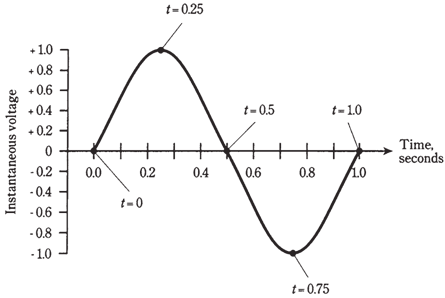Instantaneous voltage and current:
You have seen stop motion if you have done work with the video-cassette recorder (VCR). Actually, you have probably seen it if you have watched any television sportscasts. Assume that it were possible for you to stop time in the real life, any time you required. Then you could examine any instant of time in detail which would satisfy your imagination.
Recall that an alternating current sine wave has a unique, characteristic shape, as shown in the Figure given below. This is the way by which the graph of the function y = sinx appears on coordinate plane.) Assume that the peak voltage is plus or minus 1 V, as shown in the figure. Further imagine that period is 1 second, such that the frequency is 1 Hz. Let the wave start at time t = 0. Then each cycle begins every time value of t is the whole number; at every instant, the voltage is zero and is positive going.
If you freeze the time at t=446.00 seconds, say, voltage will be zero. By looking at the diagram, you can see that voltage will be zero every so-many-and-a-half seconds; that is, it will be zero at t=446.5 seconds. But instead of getting more positive at these instants, voltage will be swinging towards negative.

Figure-- A sine wave with period 1 second and frequency 1 Hz.
If you freeze time at quarter seconds, say t = 446.25 seconds, the voltage will be +1 V. The wave will be at its positive peak exactly. If you stop time at three-quarter seconds, say t = 446.75 seconds, the voltage will be at its negative peak, -1V.
At intermediate stages, say, three-tenths seconds, the voltage will have the intermediate values.